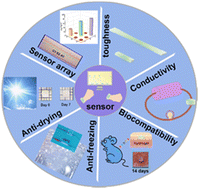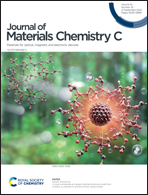Highly conductive hydrogel sensors driven by amylose with freezing and dehydration resistances†
Abstract
Conductive hydrogels are ideal materials for preparing wearable strain sensing devices due to their flexibility and stretchability. However, most hydrogels exhibit poor freezing resistance and weak water-holding ability, thus hindering the working range of hydrogel-based sensors in extreme environments. Here, a conductive hydrogel featuring conspicuous anti-freezing and water retention abilities was prepared by integrating amylose (AMY) into a polyvinyl alcohol (PVA)/glycerol/NaCl hydrogel. AMY possesses a number of hydroxyl groups, which could interact with PVA and glycerin via hydrogen bonds, enhancing the toughness of the hydrogel. Meanwhile, based on the strong hydrogen bonding between glycerol and water molecules, the hydrogel displayed water-retaining properties after 7 days of storage in an open environment. The synergistic action of NaCl and glycerol prevented the crystallization of water at low temperatures, endowing the hydrogel with outstanding conductivity and stretchability at −20 °C. Furthermore, the hydrogel-based wearable strain sensor exhibited excellent sensitivity (GF = 2.55), fast response/recovery time, and good durability and biocompatibility, which accurately detected joint movements and physiological signals at room temperature or under extreme conditions. Therefore, conductive hydrogels would possess significant application prospects in health detection, disease diagnosis, and artificial intelligence.



 Please wait while we load your content...
Please wait while we load your content...